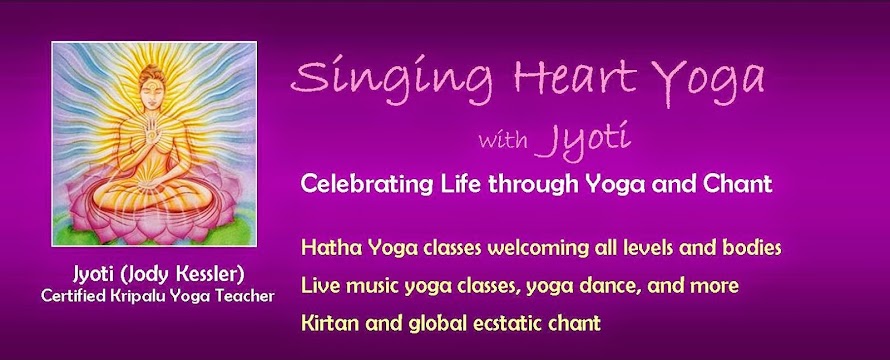At the beginning of March I attended a weekend workshop
with Erich Schiffmann, Internationally renowned yoga teacher and “star” of the
1994 video Yoga Mind & Body with Allie McGraw.
At first glance, Erich Schiffmann does not look like a
typical master yogi, with a chiseled body and intense gaze. Instead,, he looks
like a big teddy bear, with long curly locks that frame his soft face. But
listening to him speak for even just a few minutes, his wisdom and spiritual depth
become clear.
Although he teaches
regular classes at his studio in Venice, CA,
his focus has become less about postures and more about living yoga
through learning to tune in to Spirit’s wisdom and grace. When one becomes
adept at doing this, asana practice becomes an expression of the Infinite Mind.
This practice, which Erich calls Freedom Style Yoga, is very much akin to Kripalu’s practice of Meditation
in Motion—listening to where prana wants to flow and following that.
The following is a distillation of the notes I took while
attending the recent program at the Kripalu Center for Yoga and Health in the
Berkshires. More of Erich’s teachings
can be found at www.movingintostillness.com
.
Yoga is more than something we do for an hour or so at
the gym, a couple of days per week. Yoga is a lifestyle. But the “yoga lifestyle” does not require one
to wear Lululemon clothes, become vegetarian, and stand on your head every
morning. It is more about a commitment,
day after day, to be aware of “Big Mind.”
The Sanskrit word yoga means to “yoke” or “join.” What we
are doing when we practice yoga is joining, or yoking, small mind to Big Mind. Erich likens this to plugging into the
internet--we can use our minds, our intention and focus, to “get online.”
Small mind, however, is so often full of static and
distraction. The practice of meditation (which is one of the central practices
of yoga) helps us to learn to think less and listen more, so the “download from
Big Mind can come through. “
Erich says that the main reason to meditate is that it
allows us to “slide into a feeling of peace.”
He teaches that there are three ways to practice meditation:
1)Sitting quietly. He suggests a few minutes every
morning and evening.
2) Doing asana practice. Let your posture flow be a
meditation-in-motion. Structured practice should eventually flower as intuitive
practice. Once we know where to put our feet and how to align our hips and
spine, etc, this focus on alignment can then blossom and become alive. We can
move beyond “Simon Says” to an experience of channeling the poses, guided from
an inner knowing.
3) The Rest of the Time (which is most of the time!). We
can practice meditation while we are cooking, shopping, driving (eyes open, of
course!), and in all of our daily activities. What this means is that,
throughout the day, we practice thinking less and listening more, so we can “get
online.” Erich emphasizes that if we are listening and aware, we are online all
the time. We are connected if we are conscious.
With regard to pranayama (breathing) practice, Erich
teaches a very simple, basic technique: just
breathe in like you are inhaling the
fragrance of a rose. He says that there is no need to do anything fancy. But be
aware that it’s not just air you are breathing—it’s Life Force. He invites us
to let that Life Force tell us what to do, rather than manipulating it.
The repetition of mantras is a practice that can help
still the mind. You can use any traditional mantra that calls to you, or make
one up that feels appropriate.
When mantra works, eventually it will dissolve. When any
discipline works, ultimately the form dissolves, and the energy of the practice
takes over. Erich calls this the “flowering” of one’s practice. This is true
for asana, mantra, meditation, or any other discipline. We first focus on the
mechanics of the practice, and then we let it flower. We hone our instrument
and our skill set, and then we open ourselves up to become a channel for the
spirit of the practice to come through. In
this way, we may find ourselves inventing new poses, just as the original yogis
did.
When we first start a yoga practice, many of us prefer
having a teacher guide us. We come to class and listen carefully to every move
the instructor guides us to do, focusing on proper alignment and getting it “right.”
Erich emphasizes that such training is important. Get good at it—isolate specific movements and
become deeply attuned to what is happening in the body. Then, let it flower as
intuitive practice. Our training should culminate in letting the energy dictate
the flow. So we begin with structure,
which eventually dissolves and blossoms into a more organic, free-form movement
with heightened sensitivity.
“Advanced” yoga means learning to trust yourself. “Knowing flows in…then trust yourself to do
what you need. Dare to do as you are guided to do.” Through meditation, we get
better at paying attention to this guidance.
When we practice on our own and begin to allow ourselves
to be guided from within, it’s a good idea to bring a pen and paper to our
practice space. Erich also suggests a tape recorder, or even a video camera, to
capture the cool patterns and original sequences that will be channeled through
us. “You’re in class with the Infinite. Take notes!”
With all that said, Erich says that asana practice is “highly
overrated. Being more bendy doesn’t make you enlightened.” The essence of yoga is about life—about learning
to be “tuned in.”
One of the ways we can practice tuning in and developing
this intuitive power is to pay attention to how we make decisions, however
small. Erich says, “Whenever you have a
choice or decision to make, slow down and tune in. Don’t make up your mind
right away. First, pause, ‘get online’ and ask for guidance.
Whenever you find yourself having to make a decision about
something, it means that you are not clear. If you were totally clear, then
there would be no decision process—you would just intuitively know and act
accordingly. But when you are faced with a choice, then there is a momentary
lack of clarity.”
So, tuning into guidance is the practice of listening and
waiting until we are completely clear. At that point, it is no longer a choice.
It’s a clear direction—“the choiceless choice.” But Erich stresses that “we don’t
make up our own mind—we ‘get online’ and ‘google’ the answer.” Googling is Erich’s quirky and endearing way of
describing prayer, or downloading God’s guidance with regard to each situation.
Getting online and googling is something we must begin to
practice with the relatively easy decisions in our day-to-day life. Do I put on
the blue or red shirt? Eggs or cereal? Bowling or a movie? Pause, ask the
question, and then follow the choice that “glows.” Think less, listen more. Use your thinking to listen
more.
When you get “online,” you begin to connect with the
Awakened Ones who are already online (It’s kind of like a chat room with the
great sages—Jesus, the Buddha, and all the great saints and boddhisattvas. Our spiritual practice is about staying
online and connected with these great beings and asking for help.
Three things to practice every day:
Relax. Practice relaxing
all day long. Become aware of the current tension level in your being, and then
use the power of your exhale to allow it to diminish. Awareness and breath is a
powerful way to release tension.
Practice Love More. Begin
with things that are easy and natural for
you to love, and love them more than
you normally would. Pet the cat with more conscious affection. Savor your food.
You will start getting wowed by the “asanas of life” more. Then, when you are
not being loving, you will notice the contrast more easily.
“Love” is the willingness to recognize
that which is real and true. Therefore, “I love you.” means “I am willing to
recognize that which is True about you (your Divine Nature).” Be willing!
Trust Your Insights. Learn
to trust your deepest impulses about what to do. This becomes easier to do when
you are relaxed. Don’t worry about explaining your choices to others.
Erich also spoke about the meaning of the word “God.” The
dictionary definition of “God” is “Supreme Being.” Now, if we think of this Supreme
Being as a noun, that creates an anthropomorphized image of God, and implies
duality and separateness. I am here, a lowly human, and God is up there in the
sky and has dominion over me.
But if we think of Supreme Being as a verb, then wow!—it becomes
a way of being in the world that is accessible to and inclusive of everyone. We can cultivate Supreme Being as a way of
moving through our lives, cultivating exquisite presence and an open heart.
Each of us is a finite expression of the Infinite. The
great Totality is temporarily showing up as you. You only exist because the
Totality exists as you.
When you feel the loving goodness inside yourself as
yourself - as who or what you really are, you will acquire new
self-appreciation. You will realize there is no basis for being self-critical
or self-condemnatory, or for harboring guilt for some known or unknown
transgression in the past, and that you have done this until now simply because
you have accepted as true certain erroneous ideas about yourself. It's obvious
to you now that when you wipe the slate clean and take a look at yourself for
yourself, when you experience yourself as you actually are, you encounter a
very different you from the "you" you thought you were. It now makes
sense to disbelieve what was never true and embrace the new self-appraisal. You
are You; God's specific Self-Expression. ~from Moving Into
Stillness, by Erich Schiffmann.




